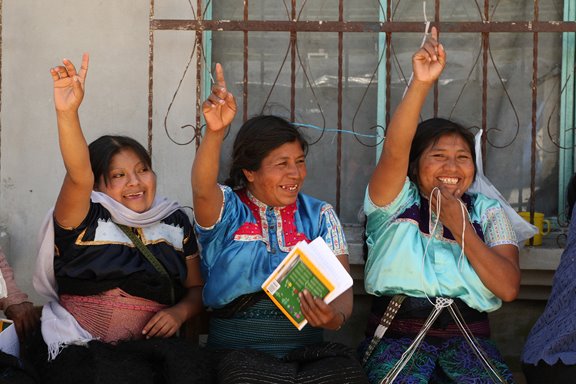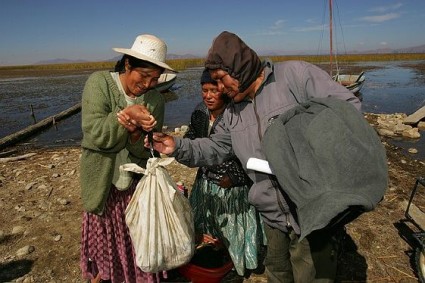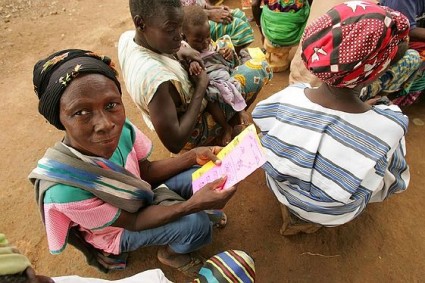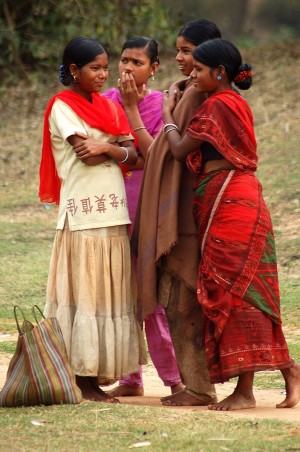FEATURED GRANTEE: Freedom from Hunger
Categorized as: Stories on March 11, 2011.

Photos © Jim Cline and Karl Grobl for Freedom from Hunger
How Freedom from Hunger first motivated us to reach beyond our own small-town privileges to get into microfinance; why they were our first partner, and why we still support them today.
Mission: Freedom from Hunger, an international development organization working in 17 of the poorest countries around the world, brings innovative and sustainable self-help solutions to the fight against chronic hunger and poverty.
Integrated services—health and education—delivered by microfinance . . . because you don’t just give someone a loan and say, “good luck with that.”
Impact: Launched in 1946 as Meals for Millions, the organization developed a high-protein food supplement still used today in global relief efforts. Already focused on the health and nutrition of mothers and small children, Freedom from Hunger created the world’s first integrated microcredit/health and nutrition education program in 1989. Today, Freedom from Hunger delivers health, business, and financial education and services to nearly 2.5 million women. Given the average family size (5.5 members), that equals a reach of 14 million.
Holding self-help as their “most cherished value”—as does the Skees Family Foundation—Freedom from Hunger employs self-help methodology to deliver self-help solutions: They work through local nonprofits and NGOs (nongovernmental organizations) to craft programs appropriate to the needs of each unique culture. Freedom from Hunger is known for its humility as well as meticulous research. Employing community resources, Freedom from Hunger ensures their programs’ capacity to continue long after startup, training, and initial funding. On the receiving end of the self-help equation, clients get access to employment and education via value-added microfinance. They gain in nutrition and health, business skills and income, all through their own efforts. More than 112 indigenous organizations in 17 countries help create permanent resources in-country for lasting impact. Freedom from Hunger focuses on very poor families in rural areas.
Nothing else matters when you’re hungry.
Poorest of the Poor: UNICEF estimates that 16,000 children die each day from causes related to hunger. That’s 16,000 too many. More than 1.4 billion people survive on less than $1.25/day, reports the United Nations–and most of them suffer from undernourishment. Until a family finds something to eat today, it’s hard to focus on anything else. Chronic hunger plagues generations of people and creates a host of problems with health, productivity, and chronic poverty.

To alleviate these problems, efforts must address root causes, be sustainable, and be implemented by local people for the long term.
Equal opportunity for families around the world.
What does hunger have to do with equal opportunity for families? Everything. Chronic hunger stunts physical growth and learning capacity. It robs families of strength when their children’s weak immune systems cannot battle such common ailments as diarrhea, malaria, and measles. It stresses mothers and fathers already worn down by the long hours and hard labor needed to earn $1-2/day. And when they have to usher all their resources into finding that next meal, we have no freedom to play, study, dream, or build.
Programs: Credit with Education brings interactive adult education in health, business, and financial management to microfinance groups, mostly in rural and periurban communities. Classes are conducted during credit meetings (when members make payments on their loans and/or collect interest on savings), on such topics as basic accounting, diversifying entrepreneurial activities, family planning, overcoming common diseases, and how to grow your sales.

Saving for Change facilitates village banking among very poor village women who collect savings, make loans, charge and pay out interest and fees, all on their own, to support each other’s small-business ventures and family expenses. The only cost?—startup funds, sometimes as little as 50 cents per person, and staff training. Not only does each group write their own terms and rules, they train “replicators” to go out and start new savings circles in neighboring villages. This requires only human capital in terms of donated hours. Financial cost: zero.
Microfinance and Health Protection combines financial services such as health loans, health savings accounts, and microinsurance, with access to health education, services, and providers. The goal is to cultivate thriving health among microfinance clients and their families—because too often, when a family member is sick, work time gets lost and precious savings get spent on illness, causing a family to backslide into hunger. When a mother learns simple methods for treating her baby’s diarrhea, or a husband can rest assured that the family’s health protection plan will cover his wife’s malaria treatment, everyone can focus on moving forward.
Advancing Integrated Microfinance for Youth (AIM Youth) extends financial education and services to the “Next Generation” who, rather than being caught in a cycle of poverty, learn ways to contribute to their families’ household budget, get the academic and job training they need, and work their way into a self-determined future.

Our connection: The Skees Family Foundation begins at the bottom of the pyramid, both in whom we strive to serve–the more than 1.4 billion living on less than $1.25/day–and the most basic human rights of Maslow’s hierarchy of needs. It’s tough to do your homework if your stomach is cramping in pain.
We have supported Freedom from Hunger since 1992 as a family and since 2005 as a foundation. Because we have built a collaboration based on respect in action, we can support this organization on several levels:
- Operations: support of vital research methodology and metrics testing, site visits and partner-staff training, international administration and program development;
- Scale: efforts, such as the recent “Reach Three Million” campaign, to cast a wider, deeper network of care to the poor by expanding delivery networks;
- Fundraising efforts;
- Healthcare: current program to bring adult education on health issues and micro insurance and linkages to reliable, affordable health services, to urban and rural ultrapoor in India; and
- Stories: travel with and detailed writing on the local staff, client members, and self-help communities of Freedom from Hunger.
Freedom from Hunger: Our wish for the whole world.
DONATE directly to Freedom from Hunger here.
SUBSCRIBE! Like what you see? Click here to subscribe to Seeds of Hope!
